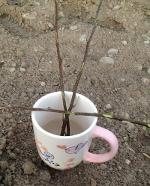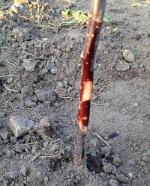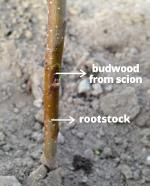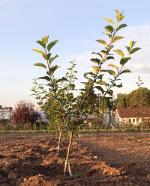Apple Rootstock Trial
Project background
We are conducting this trial in order to provide local data for Montana commercial dessert and cider apple growers as well as homeowners. Our research team is testing six different apple rootstock cultivars, described in the table below. We chose cultivars that would contrast a range of tree sizes and disease tolerances and compare industry standards with the newer 'Geneva' series. We specifically included 'M26' as some growers have found it to be very cold tolerant; however, growers in other locales tend to avoid it due to its extreme susceptibility to root diseases. To our knowledge, cold tolerance in 'M26' has not been field tested. Also note that after planting the trees for this rootstock trial, we learned of another cold tolerant rootstock—'Antonovka.' Its fruit happens to be suitable for fresh eating. However the rootstock is vigorous and grows a full-size tree.
We used 'EverCrisp' as the scion for grafting onto the rootstock using the the bud grafting technique shown below. 'EverCrisp' is a new variety from the Midwest Apple Improvement Association, with 'Honeycrisp' and 'Fuji' parentage. It is supposed to store well, staying firm and tasting great for months after harvest. We will test its viability in Montana, documenting its precocity (how old the trees are when they can support a crop) on the rootstocks in our trial, as well as yield, storability, fire blight incidence, bitter pit incidence, bloom and ripening dates, and other horticultural characteristics.
Our trial is set up as a randomized complete block design with 11 blocks and 1 tree of each rootstock cultivar per block (see the rootstock trial map). The 12th block was left un-grafted intentionally. We want to see how large the rootstocks grow on their own, and are curious to see if the fruit of the rootstocks is useful for cider making, especially for the varieties with disease and cold tolerance.
Steps in bud grafting
| Rootstock | 'Budagovsky 118' | 'Geneva 890' | 'Geneva 935' | 'Malling 7 EMLA' | 'Malling 9 selection NIC 29' |
'Malling 26 EMLA' |
|---|---|---|---|---|---|---|
| Abbreviations | Bud.118, B.118 | G.890 | G.935 | M.7 EMLA | Nic 29®, M.9 Nic 29 | M.26 EMLA, EMLA 26 |
| Tree size | Semi-dwarf 1,2 | Semi-dwarf 1,3 |
Dwarf 1 Semi-dwarf 6,10 |
Semi-dwarf 3,5 |
Semi-dwarf 1 Dwarf 3,6 |
Dwarf 8,9 |
| Productivity |
Moderate 2 Decreases annually 7 |
Higher than M.7 1 Good 8 |
Good 2 | Not impressive 5 | Good 1 | |
| Precocity | Early 2 | Intermediate 1 | Early 1,2 | Very early 1 | Very early 1 | |
| Winter hardiness | Very hardy 1,2,3,7,8,9 | Hardy 3,7 |
Hardy 1 Very hardy 8 |
Low 5 Moderate 1,7 |
Hardy 1 Low 7 |
|
| Tree support needed | No 1,2,9 | No 1,3,8 | Yes 1,2 |
Yes, staking for trunk support first 4-5 years 4 No, when planted in deep, well-drained soils 3 |
Yes 1 | Yes 8 |
| Fire blight resistance |
Moderate 1,2,3,7 Low 6 |
High 1,3,7,8 | High 1,2,3,6,7,8,9 |
High 6 Low 7 |
None 1,3,7 | Low 4,8,9 |
| Crown/root rot resistance |
Moderate 1,2,7 |
High 1,3,7,8 | High 1,2,3,6,7,8 |
Moderate 6,7 |
Moderate 1 High 7 |
Moderate 1,2 |
| Replant disease resistance |
Low 7 |
High 7,8 | High 7,8,9 | Moderate 7 | Low 7 | |
| Woolly aphid resistance |
None 7 |
High 1,3,7,8 | None 1,3,7,8,9 | None 7 | None 1,7 | None 9 |
| Suckering |
None 3 |
Moderate 1,2 Low 9 |
High 1,3,4,5,7 | Moderate 1 | Low 4 | |
| Burrknots | Yes 6 | Yes 4,8 | ||||
| Other notes |
Resistant to apple scab 8 Adaptable to various soil types (as long as well-drained); some bitter pit in WA 7 |
Bitter pit a concern; good replacement tree in difficult soils 7 |
Well-adapted to most soils 2 Good rootstock for weaker scion varieties 7 |
Protect from wind; bud high and plant deeply in good soils 5 | Works well with slow-growing scions 7 | Trees should be planted with graft a few inches aboveground 4,8 |
Results through 3/24/2021
In spring 2021, rootstocks will be entering their second year at WARC (planted in spring 2019). We summarize information on tree survival, tree size, and cold injury below.
Brief timeline
- 04/26/2019 - rootstocks planted
- 08/06/19 - 08/08/19 'EverCrisp' grafted to rootstocks
- spring 2020 - graft and rootstock survival documented (data not shown)
- fall 2020 - 'EverCrisp' re-grafted to rootstocks where grafts failed; two buds this time
- 09/20/20 - survival and diameter documented
- 10/25-26, 2020 - temperatures reach minimum -5 ˚F, following a mild fall
- 03/23/2021 - cold injury documented
Tree or rootstock survival
|
Cultivar
|
Number alive out of
number planted |
Percent survival1
|
|
|---|---|---|---|
|
'M9Nic29'
|
12 of 12
|
100%
|
a
|
|
'Bud118'
|
11 of 12
|
92%
|
ab
|
|
'EMLA 26'
|
11 of 12
|
92%
|
ab
|
|
'M7'
|
11 of 12
|
91%
|
ab
|
|
'G890'
|
8 of 12
|
66%
|
ab
|
|
'G935'
|
5 of 12
|
58%
|
b
|
|
1 Pearson’s exact chi-square: Χ2 = 12, df = 5, p = 0.0393 (significant). Cultivar
comparisons established by pairwise Pearson’s chi-square tests with p < 0.05. |
|||
Tree size
| Cultivar | Trunk diameter (in)1 | |
|---|---|---|
| 'G890' | 15.3 | a |
| 'Bud118' | 13.7 | ab |
| 'G935' | 11.8 | bc |
| 'M7' | 10.7 | c |
| 'M9Nic29' | 10.6 | c |
| 'EMLA 26' | 10.5 | c |
|
1 ANOVA type III sums of square (cultivar), 12.65, p-value, <0.001; Tukey-Kramer post-hoc
means separation. Means followed by different letter are statistically different.
|
||
Cold injury
We had a mild fall in 2020, with only several light frosts prior to temperatures dropping suddenly to lows of -5 ˚F on October 25 and 26. On in spring 2021 (03/23/21), we recorded the presence of cold injury (yes or no) (branch dieback, sunken bark), on either the scion or the rootstock, which we attribute to this sudden cold. Cold injury was more obvious and severe on ungrafted rootstocks than the scion. In addition to extreme cold midwinter in parts of Montana, sudden temperature drops in late spring or early fall are not uncommon: resilience to these conditions could be an important cultivar characteristic.
| Cultivar | Cold injury 03/23/21 (note some trees had died prior to cold temps) | Percent with cold injury1 |
|---|---|---|
| 'M9Nic29' | 5 of 12 | 42% |
| 'Bud118' | 0 of 11 | 0% |
| 'EMLA 26' | 3 of 11 | 27% |
| 'M7' | 4 of 11 | 33% |
| 'G890' | 1 of 8 | 13% |
| 'G935' | 2 of 5 | 40% |
|
1 Pearson’s exact chi-square: Χ2 = 7.31, df = 5, p = 0.2075 (not significant).
|
||
Downloadable file
| Printer-friendly PDF of this page |
Sources
- USDA Cooperative Extension
- Washington State University
- PennState Extension
- University of New Hampshire Extension
- Ontario - Ministry of Agriculture, Food and Rural Affairs
- University of Missouri - Integrated Pest Management
- Good Fruit Grower
- TRECO® - Oregon Rootstock & Tree Company
- Adams County Nursery - 2017-2018 Fruit Tree Catalog
- HortScience - Volume 40: Issue 4
Some Grafting Terminology
Grafting
Apple growers use grafted trees in order to produce a uniform crop that will perform
well for their market goals and for the local site conditions. Grafting involves fusing
the stem of one species or cultivar of tree or vine with a different, compatible type
to create a plant with desirable characteristics of both types.
Rootstock
The rootstock composes the lower part of a grafted tree—including the root system
and basal part of the stem. Fruit growers choose rootstock cultivars for their ability
to impart characteristics such as pest and disease resistance, environmental stress
tolerance, higher productivity, and/or tree size.
Scion
The upper portion of a grafted tree arises from the scion. Scions are pieces of stem
containing buds or shoots collected from a differing cultivar and grafted onto the
rootstock. The scion cultivar is selected mainly for the qualities of its fruit.






